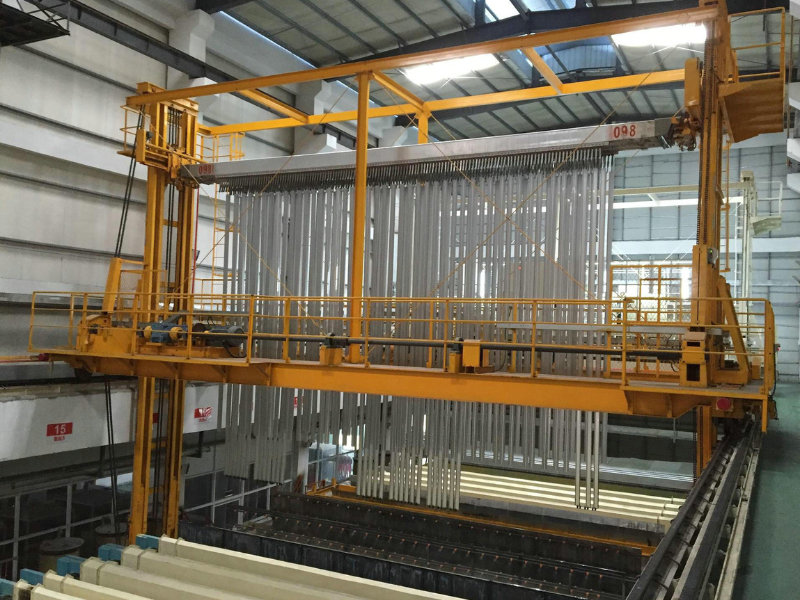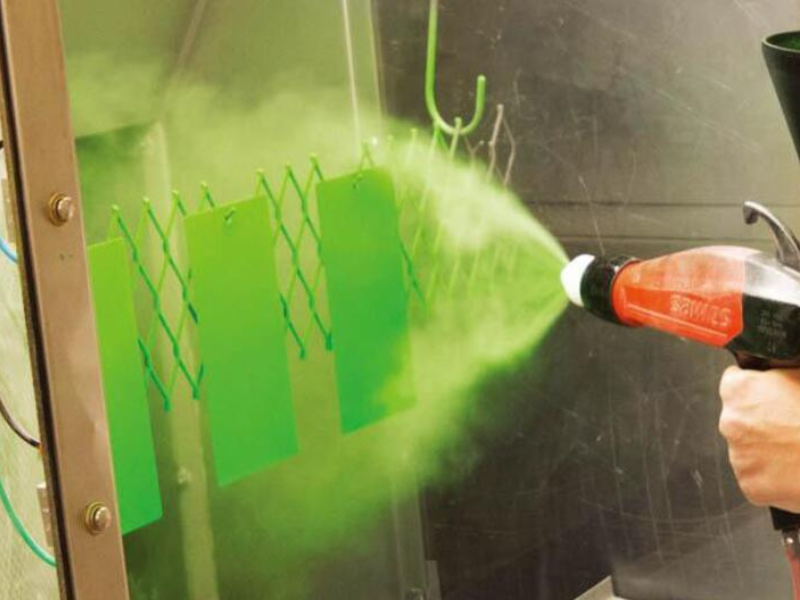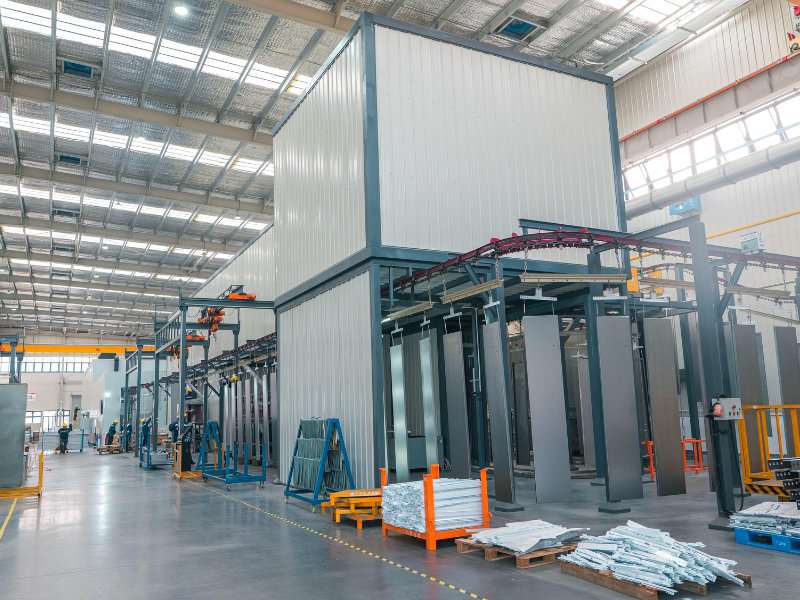In the aluminum industry, aluminum profiles are often surface-treated for aesthetic reasons and to enhance performance. There are many methods for aluminum surface finishing, the two most common of which are anodizing and powder coating. Whether you are a purchaser or a manufacturer, you need to pay attention to the differences between these two processes. This is because the surface treatment process directly affects product performance, cost, and customer satisfaction.
In this article, we’ll explain the differences between aluminum anodizing and powder coating, including how each process works, performance comparisons, and suitable applications.
What Is Anodizing
Anodizing utilizes electrochemical principles. Aluminum extrusions are immersed in an acidic electrolyte and then subjected to an electric current. Oxygen ions released from the electrolyte bond with aluminum atoms on the aluminum surface, forming a durable, porous aluminum oxide layer. Unlike coating methods, which add external coatings, anodizing transforms the metal surface itself into a protective oxide film that blends seamlessly with the aluminum, rather than forming a separate film.

Advantages of Anodizing Surface Treatment for Aluminum Profiles
The porous oxide film formed by anodizing can achieve a hardness of up to 500 HV. This porous structure allows the aluminum profile to more readily absorb lubricants, pigments, and other materials, making it more corrosion-resistant and aesthetically pleasing. Generally speaking, the lifespan of the anodized coating is proportional to the thickness of the aluminum oxide surface. It offers excellent insulation, with a breakdown voltage exceeding 30V/μm, and boasts high temperature resistance, reaching 1500°C. Its excellent adsorption capacity allows it to be oxidized and colored to desired decorative colors. It is widely used in aerospace, electronics, various aluminum profile frame construction, and architectural decoration.
Disadvantages of Anodizing Surface Treatment for Aluminum Profiles
The anodizing process for aluminum alloys includes the following steps:
1. Mechanical polishing.
2. Cleaning and degreasing.
3. Removes copper or other impurities on the surface of certain alloys.
4. Places the aluminum profile in dilute sulfuric acid as an anode and applies electricity to form a surface oxide layer.
5. If decorative color is desired, dye can be absorbed into the micropores of the oxide film, a process known as dyeing.
6. Heat or use of a chromate solution to seal the pores of the surface oxide layer.

However, this process is prone to problems. For example, the oxide film can easily become mixed with impurities and turn yellow. Materials can easily stick together, resulting in uneven oxidation coloration and iridescence, which can adversely affect the product’s appearance. Excessively high electrolyte temperature or prolonged electrolysis time can cause a white, opaque powder to form on the surface of the aluminum profile. Improper control of the sulfuric acid concentration during alkaline etching can reduce the profile’s corrosion resistance. The surface of the oxide film is also prone to various appearance quality problems such as burning, whitening, blackening or darkening.
What Is Powder Coating
Powder coating involves applying powder coating to a spray gun. Compressed air, high-voltage static electricity forces the powder particles to adhere to the surface of the aluminum profile. This process is also known as electrostatic powder coating. Unlike anodizing, which only alters the aluminum surface, powder coating creates an additional protective layer on the metal, providing both corrosion protection and vibrant color options.
Advantages of Powder Coating for Aluminum Profiles
The resin used in powder coatings has a higher molecular weight than solution-based coatings, imparting excellent chemical resistance to aluminum profiles. A single application of powder coating can achieve a coating thickness of 50-300μm, significantly reducing the number of coats and saving time. Powder coatings eliminate the dripping and pinhole defects associated with solution-based coatings, resulting in thicker films and a durable, durable aluminum profile. The rich colors enhance the decorative effect. The surface quality and pre-treatment requirements of the aluminum substrate are less stringent than those of the previous two treatment methods.

Disadvantages of Powder Coating for Aluminum Profiles
If the powder coating used is of poor quality, containing dust or impurities, it will cause granular defects on the profile surface. Impure compressed air containing oil or water can also cause shrinkage defects on the aluminum profile surface. Improper raw material formulations can affect the aluminum profile’s physical properties, including hardness, impact resistance, and bending resistance, as well as its chemical resistance. This can also result in poor surface finish and yellowing, which can lead to poor appearance.
Key Differences Between Anodizing and Powder Coating
The following is to give you a clearer understanding of the differences between the two processes:
| Aspect | Anodizing | Powder Coating |
|---|---|---|
| Process | Electrochemical oxidation | Electrostatic coating + curing |
| Layer Thickness | Thin (5–25 μm) | Thicker (50–150 μm) |
| Durability | Excellent corrosion resistance | Excellent impact and chemical resistance |
| Appearance | Metallic look, limited color options | Glossy, matte, wide color choices |
| Cost | Moderate | Slightly higher for small batches |
| Maintenance | Easy to clean, long-lasting | May chip if surface damaged |
| Applications | Aerospace, marine, electronics | Architecture, furniture, machinery |
In summary, anodizing is an ideal choice for applications requiring high precision, a metallic appearance, and excellent corrosion resistance. Powder coating is preferred when color customization, decorative appeal, and moderate durability are project priorities. Compared to anodizing, powder coating offers virtually unlimited color options.
When considering lifespan, budget, and production volume, anodizing is generally more durable and has lower maintenance costs. For large-scale production, anodizing is more suitable, offering high production efficiency and a moderate cost. Powder coating may have a higher initial cost, but it may be more suitable for small batches or projects requiring a variety of color options.
Typical Application Scenarios and Case Studies
Anodizing Process Application Examples
- High-end Commercial Buildings: The exterior walls of a luxury flagship store in a first-tier city utilize sulfuric acid anodized (15μm film thickness + nickel salt sealing) aluminum veneer panels.The metallic finish aligns with the brand’s positioning, offers six years of outdoor wear without fading, and stains can be wiped clean with water, resulting in low maintenance costs. This contrasts with spray coatings, preventing dark coatings from bleaching due to sun exposure.
- Precision Digital Products: The midframe of a high-end mobile phone from a certain brand utilizes 6061 aluminum alloy hard anodized (20μm film thickness).HV550 hardness provides scratch resistance, eliminating the risk of coating peeling, and the metallic finish enhances the product’s quality.
- Extreme Environment Components: The fuselage frame of a drone utilizes 7075 aluminum alloy, utilizing oxalic acid hard anodizing (50μm film thickness).Its lightweight design and HV600 hardness provide resistance to high-altitude UV rays and low temperatures, providing corrosion resistance and balancing performance and weight requirements.

Powder Coating Application Examples
- Civil Building Decoration: Residential Community Interior Ceilings, White Polyester Powder-Coated Aluminum Panels (80μm Film Thickness + Phosphate Treatment). The color complements the home decor style, and the price is 30% lower than anodizing. It is resistant to oil smoke and easy to clean, meeting residential environmental protection requirements.
- Outdoor Advertising Signage: Highway Service Area Billboards, Blue Fluorocarbon Powder-Coated Aluminum Frames (100μm Film Thickness).The striking color, 12-year service life, and UV and rain resistance eliminate the need for frequent replacement, reducing long-term costs.
- Customized Interior Design: High-end B&B Wood Grain Background Walls, Wood Grain Transfer Fluorocarbon Powder-Coated Aluminum Grilles (90μm Film Thickness). The realistic wood grain complements the natural style. Aluminum is more moisture-resistant than solid wood, and there are no dust accumulation gaps, creating a harmonious blend of metal and natural styles.
Shenghai Aluminum is a professional aluminum extrusion manufacturer specializing in custom aluminum finishes for architectural, industrial, and decorative applications. Contact us today for a quote and samples to help you choose the right finish for your aluminum product.

